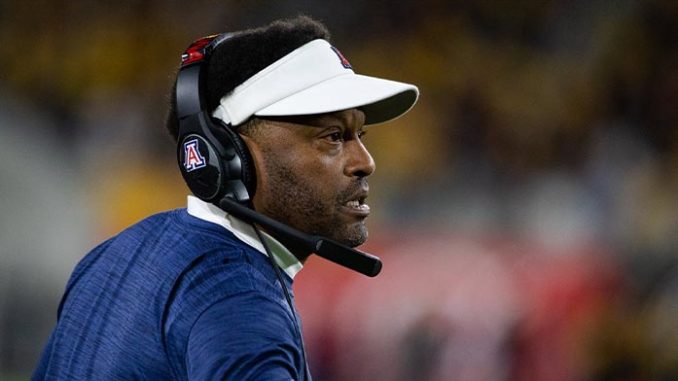
TUCSON – Khalil Tate sat on the cramped podium for postgame interviews at Sun Devil Stadium in Tempe, reflecting on the final collegiate game of his career for the University of Arizona.
His other time in the Territorial Cup, the quarterback was a sophomore who had just set the college football world on fire with an unbelievable final two months, garnering Heisman Trophy buzz. Though his team lost, he still has an efficient night before suffering an injury midway through the third quarter, completing 11 of 13 passes for 132 yards and rushing eight times for 28 yards.
This time, he was a senior who had spent the last six games splitting quarterback duties with freshman Grant Gunnell, but was the only quarterback in the 24-14 loss to Arizona State, his first full game under center since Oct. 5.
It was the final stop on a journey that was unquestionably unique.
“I would say my experience was definitely different,” Tate said. There was a lot going on since the time I got here. Sophomore year was pretty good. Junior year, I battled injuries, and then this year, just going through a lot of adversity. So, it’s definitely a learning experience for me, and I think for anybody else that followed my story – knowing you can be up and you can be down. I’ve seen both sides of that.”
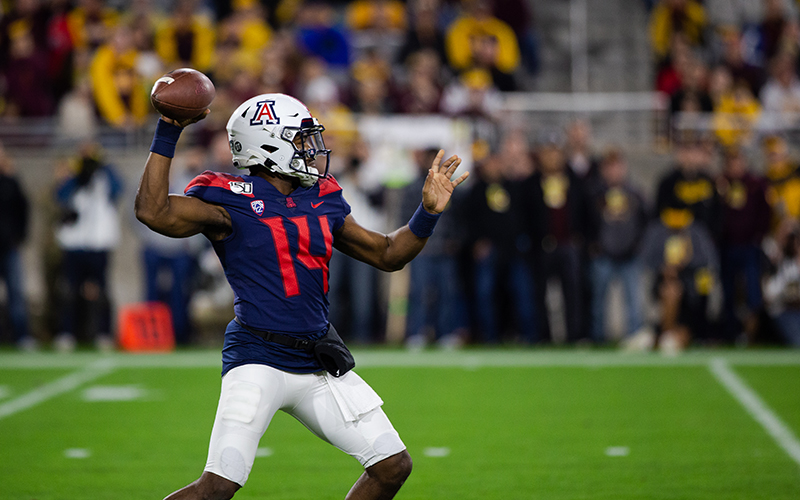
Tate rushes for a first down in the first half of the Territorial Cup. He started every snap at quarterback for the Wildcats with 228 yards passing and 78 yards on the ground. (Photo by Sarah Farrell/Cronkite News)
On this night, Tate completed 22 of 38 passes for 228 yards, throwing two touchdowns and three interceptions, while adding 11 rushes for 79 yards. It’s nowhere near some of his best performances from his sophomore year, but it was good enough for coach Kevin Sumlin to leave him in for the whole game.
“He had a good week of practice,” Sumlin said. “It was no different than how we were making decisions before that. The game flow was different, probably, than the last two weeks because it was a tight game. He was running and using his legs to create some more offense, so we decided to just go with him.”
The loss meant the second season under Sumlin would finish with a seven-game losing streak and a 4-8 record. It’s the second-straight year the Wildcats will miss a bowl, a stretch that followed up a run of eight bowl games in 10 seasons from 2008-2017.
But immediately after the game, Arizona athletic director David Heeke told reporters Sumlin would remain the coach for the Wildcats heading into the 2020 season.
“I just want to make it real clear that as we embark into year three of this rebuild program, Coach Sumlin is our head football coach,” Heeke said. “We’re not where we want to be. This isn’t what we wanted, the spot we wanted to be at this point. But we’re committed to the process of moving this thing forward, moving into year three, and getting a defensive coordinator on board, continuing to build through player development and continuing to build the talent level and the number of players through recruiting.”
But with the football talent in Arizona widely regarded as good as it has ever been and the early signing period coming fast, will Sumlin get some of the top players in the state to come to Tucson and play for the Wildcats? And will that even matter to the fan base, which has stayed away from Arizona games after building big expectations for the Sumlin era?
Joiner’s journey
Jamarye Joiner knew he wanted to stay in his home state of Arizona when he went to college. But as the Tucson native went through the recruiting process in his senior year, he had to make sure the Arizona schools wanted him amid turmoil.
“It was super up in the air because a lot of stuff was happening,” Joiner said of his recruiting process.
When Arizona and Arizona State met in 2017, both teams’ coaches – Rich Rodriguez at Arizona, Todd Graham at Arizona State – were wrapping up their sixth year in charge. But even though Graham led the Sun Devils to a 42-30 win on Nov. 25, 2017, he was fired by ASU athletic director Ray Anderson the next day. That same day, Texas A&M had fired its coach, Sumlin.
A dual-threat quarterback in high school, Joiner was committed to Arizona but had continued to be recruited by both schools at the time. When Graham was let go, Joiner said it solidified his commitment to the Wildcats, even after Arizona State hired Herm Edwards on Dec. 4, 2017.
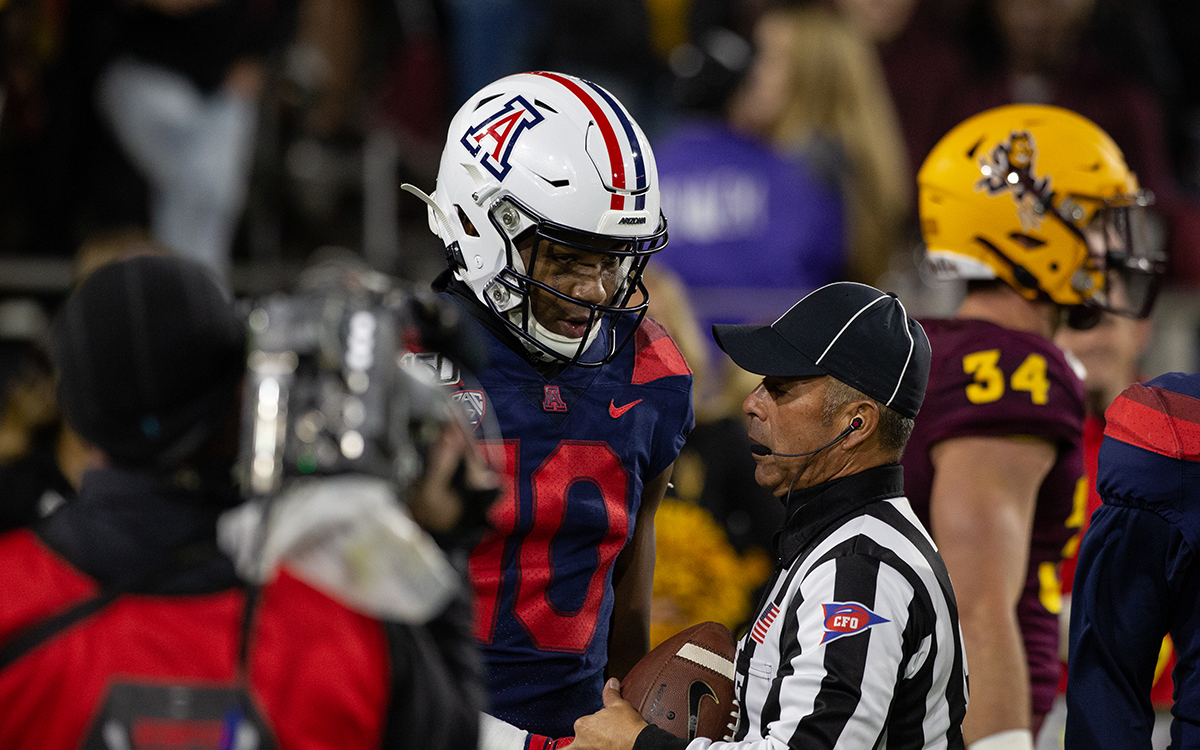
But during this time, Rodriguez was under investigation by the university because of an allegation of sexual harassment and a hostile-workplace lawsuit by a former employee. Rodriguez coached the Wildcats in their bowl game, a 38-35 loss to Purdue in the Foster Farms Bowl on Dec. 27, 2017, but was fired on Jan. 2, 2018.
So what was life like for a recruit like Joiner during this time?
“It was really hard,” Joiner said. “It wasn’t just with ASU or Arizona. UCF, Coach (Scott) Frost, Coach Frost went to Nebraska and then Nebraska offered me. And then UCF offered me. So it was a real big debacle kind of thing with offers.”
Joiner flew to Florida to visit UCF, but still had his mind set on staying in-state … depending on the coach that was hired. But Joiner couldn’t believe his luck when, on Jan. 14, 2018, Arizona announced it had hired Kevin Sumlin.
“Coach Sumlin was one of those dream coaches I wanted to play with,” Joiner said. “That was my determining factor of me staying here.”
Sumlin went to on a home visit and “blew the top off” of Joiner, who said he was “1,000% committed” after meeting with the coach. But when Joiner officially signed his National Letter of Intent (NLI) on National Signing Day on Feb. 7, 2018, he was one of only five players to do so.
That’s because 2017-18 was the first year with an early signing period for football, a 72-hour window in the middle of December when players can sign their NLIs. Previously, the only time football players could sign began on the first Wednesday of February and ran through the end of March.
Out of the 21 recruits the Wildcats signed in the Class of 2018, 16 of them had already signed before Rodriguez was fired, with only five players signing in February after Sumlin was brought aboard. For Joiner, the coaching turmoil for both Arizona schools was a factor in his decision to wait until the later date to sign his NLI.
“Coming down to the end of every season, you don’t know what the school’s thinking about their head coach,” Joiner said. “So I don’t want to just jump in to committing to a school, signing the dotted line and making it official until I knew for sure who I was playing with. That kind of played a big part in to what I did.”
That’s made Joiner unique in the two years of the early signing period, something Sumlin is quick to point out as to why the Wildcat coaching staff has hit the recruiting trail so hard in the immediate aftermath of the season.
“We hit the road tomorrow,” Sumlin said in the postgame press conference on Nov. 30. “Last year, the national statistic was around right at 80-percent of high school guys, junior college guys, both prospects, signed during the early signing date. From that standpoint right now, everybody has turned to that early signing date (and it) is extremely important.”
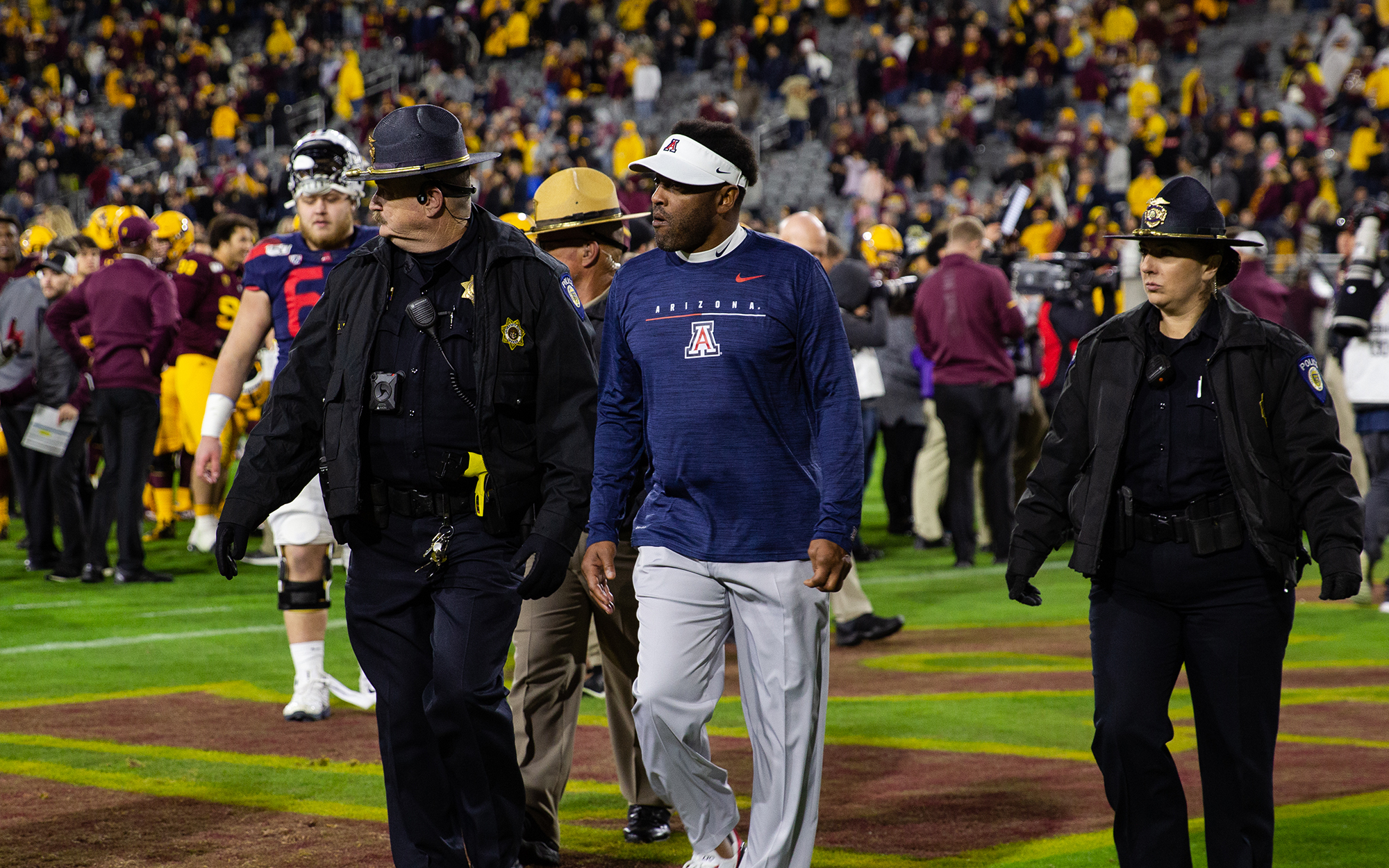
Recruiting challenges
But while Arizona football’s Twitter account has shown the coaching staff going far and wide across the country to recruit, there’s been one state that hasn’t appeared as much, especially for Sumlin.
Arizona.
According to 247 Sports, as of Wednesday, Dec. 11, the Wildcats have picked up 14 commitments from Class of 2020 recruits. Only three of those commitments come from Arizona players. Although Sumlin will undoubtedly be adding more commitments to the Wildcats’ 2020 class over the next two weeks – including picking up a commitment from Regen Terry, a defensive end from Florence that 247 Sports rates as a 3-star recruit, this comes a year after he only signed two Arizona kids in the Class of 2019.
The focus away from the home state comes at a time when the rest of the country continues to view Arizona – and Phoenix in particular – as an emerging football hotbed. It’s something even Sumlin sees, saying the talent level has “increased exponentially” since he first came to Arizona more than a decade ago.
“With that population growth and coaching and people moving there, the talent level has grown,” Sumlin said. “I think you saw it this year with the change in the system with the playoffs and the Open Division this year, which has been really exciting, except for my son and some other people here in town last weekend. It’s a chance, in that Open Division, when they seeded the top 8 teams, you’re seeing some really, really good football. And a lot of talent in that bracket.”
In fact, just 2.2 miles away from Arizona Stadium sits Salpointe Catholic High School, where Sumlin’s son Jackson is a senior and the football team reached the Open Division semifinals. A recent story from Ari Wasserman of The Athletic wondered why Arizona did not push harder for three “blue-chip” recruits – 4-star or 5-star rated players — at Salpointe Catholic.
Jack Cooper is the sports editor of The Daily Wildcat, the school’s student newspaper, as well as a lifelong Tucson native. Cooper said it was “frustrating” to watch all three top prospects from a school so close to campus leave, and feels it’s part of a bigger trend for the current coaching staff.
“It seems like Sumlin gets a lot of recruits from Texas and California, and those are obviously two of the biggest college football recruiting places, especially with his ties in Texas,” Cooper said. “But you can’t forget about your own state and Arizona, and especially with Phoenix becoming one of the [hotbeds].”
In fact, using 247’s ranking of Arizona’s top football prospects, the Wildcats only have one commitment from the top 30 players in the Class of 2020. That would still be an improvement over the Class of 2019, when they signed none, and the top Arizonan player in 247’s rankings to sign with the Wildcats was ranked 34th.
“We evaluate them based on what our evaluation process looks like,” Sumlin said. “Wherever I’ve been, at different schools, sometimes, those guys, when we evaluate and we recruit them, sometimes those stars, they go up, and sometimes, they go down. Our process is about, ‘Who can help us? Who can help us win in our systems?’ Whether that’s special teams, offense and defense. Our evaluation process is based on that, not based on the Internet.”
Chasing victories
When it comes to on-the-field results, though, there’s only one way programs will ultimately measure success: wins.
Through two years of the Kevin Sumlin era, the Wildcats have severely underwhelmed in that regard.
When Sumlin was hired, the immediate reaction from across the college football landscape was that it was a great match, with Dennis Dodds of CBS Sports writing that “a coach of Sumlin’s ability” could get Arizona to its first-ever Rose Bowl “rather easily, especially since Rich Rod didn’t leave the cupboard bare.”
That stocked cupboard included Tate, who finished his sophomore campaign in 2017 with 1,591 passing yards, 1,411 rushing yards and 26 total touchdowns (14 passing, 12 rushing) in just 11 games. Combined with then-redshirt freshman running back J.J. Taylor (847 rushing yards, five touchdowns) and then-junior wide receivers Shun Brown (573 receiving yards, six touchdowns) and Tony Ellison (525 receiving yards, five touchdowns) and Arizona looked poised to compete for the Pac-12 South championship in 2018, with Pac-12 media picking the Wildcats to finish third in the South in their preseason poll.

After the hire, longtime Tucson Daily Star columnist Greg Hansen wrote that Sumlin’s hire was “a home run” and asked, “Who doesn’t think the Run for the Roses begins anew?” Sumlin did try to temper that buzz in a Q&A with The Athletic’s Chantel Jennings in the first few weeks after he was hired.
“Everybody is going to have their own expectations of what we can do. My job is to win every game and be competitive in every game and let the chips fall where they may,” Sumlin said when asked what were realistic expectations for 2018. “If we’re good enough, we’re good enough. Try to get better every year, that was a question people asked me at the end at A&M. We never had a losing season in probably the most difficult division in college football in the country. If you’ve improved the program from where you got it to where it is whenever you walk away from it, then you’ve been successful.”
But when 2018 kicked off, the Wildcats lost their first two games, a tight home loss to BYU before getting blown out at Houston – where Sumlin got his first head coaching job. The Wildcats never won or lost more than two games in a row, and what Hansen had said was going to be “seemingly a perfect fit” between Tate and Sumlin also sputtered, with Tate fighting a variety of injuries all season and mostly staying in the pocket as a passer.
The high point of 2018 was blowing out a ranked Oregon team, 44-15, and following that up with a win over Colorado, the defending Pac-12 South champions, to get to 5-5 with two games left. But the Wildcats were blown out by Washington State, 69-28, before returning home for a bitter Territorial Cup where Arizona blew a 19-point fourth quarter lead and missed a last-second field goal to lose to Arizona State 41-40. The Wildcats missed a bowl for just the third time since 2007.
Even after a disappointing 2018 brought outside expectations down, as the Pac-12 media preseason poll slotted the Wildcats fifth in the South, the Tucson Daily Star’s Arizona beat writer, Michael Lev, wrote that the team “should be better” in 2019. With a year to get used to a new coaching staff, plus improved depth and a healthy Tate entering his senior year, the reasons for optimism were aplenty.
Even though Arizona opened its season with a 45-38 loss at Hawaii, when Tate’s last-second scramble for the end zone for a potential game-tying touchdown ended one yard short, the Wildcats recovered and got hot, winning their next four games to get to 4-1 and first place in the Pac-12 South, the only team left unbeaten in the division.
But from then on, everything crumbled. Especially on the defensive end.
51 points allowed to Washington. 41 in back-to-back road games at USC and Stanford. 56 points on Homecoming Saturday to Oregon State. 34 points allowed at Oregon, and 35 at home against Utah. All six games were losses, a losing streak that took a team from the top of the Pac-12 South to the bottom.
Sumlin fired three defensive coaches during the 2019 season, letting go of defensive coordinator Marcel Yates and linebackers coach Josh Rushing on Oct. 27, and later dismissing defensive line coach Iona Uiagalelei on Nov. 21. Combining the coaching changes during this season with the prior upheaval are a major part of why redshirt senior defensive lineman Finton Connolly described his time in Tucson as a “crazy ride.”
“It’s always hard, but as a player, you just have to adapt to any coach that you get and that the coach brings in,” Connolly said. “And you’ve got to trust that what that new D-line coach is bringing is going to help you be successful.”
As a Gilbert native, Connolly described the 2019 Territorial Cup as his “bowl game” and was a key part in a stout defensive showing in the first half, helping Arizona take a 7-6 lead into halftime. But in the second half, the Sun Devils leaned on the run game and powered through the Wildcat defense, leading Arizona State to a 24-14 win for its third-straight win over Arizona.

It was the final game for both Connolly and redshirt senior safety Jace Whittaker, who kept his description of his time at Arizona brief when asked after the Territorial Cup.
“It was a roller coaster,” Whittaker said. “It was a fun one to be a part of. Lot of ups and downs.”
An apathetic fanbase?
The roller coaster that players felt the last half-decade of Wildcat football has been was also felt by the fanbase. But Wildcat fans may be starting to show their displeasure in the place that would be most noticeable: the athletic department’s bottom line.
Across six home games in 2019, the Wildcats had 237,194 people in attendance for their games at Arizona Stadium, an average of 39,532 fans per game. Both the total and the per-game average were the lowest at Arizona Stadium since 1975. It’s the first time since the Wildcats joined the then-Pac-10 in 1978 that they’ve averaged less than 40,000 fans per home game.
Interest and turnout also waned in anecdotal senses, too. There was around 15-18 fans at Sumlin’s final weekly radio show at Playground in downtown Tucson, with one attendee describing the crowd there as “just the usuals” save for this reporter.
And maybe the most noteworthy observation for longtime sports fans in the state was that the Wildcat fan presence at the Territorial Cup was noticeably lower than previous games at Sun Devil Stadium, according to multiple eyewitnesses that have attended many Arizona versus Arizona State games (though the 8 p.m. kickoff time didn’t help convince anyone from Tucson to make the 110-mile drive to Tempe, surely).
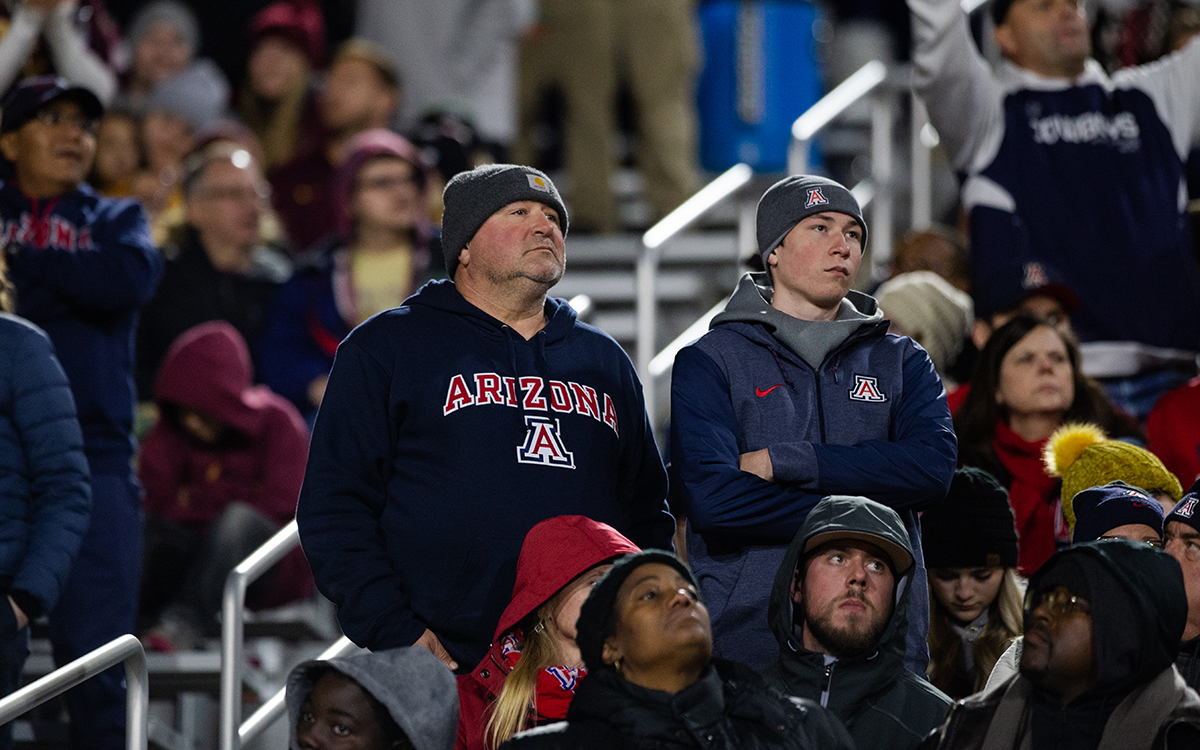
Both of Cooper’s parents went to the University of Arizona, taking him to games ever since he was born. He’s seen how excited Wildcat fans can get when the team is going strong.
“The fan base is here for football,” Cooper said. “You just have to put a product on the field that the fans can actually cheer about. People have just kind of gotten used to 7-win seasons.”
It’s why the two seasons without bowl appearances hurt so much. Make no mistake, Sumlin is well aware of the fan base’s feelings of how his two years in charge have gone. But he believes in the group he has – coaches, staff, and players – are ready to move forward and make things better.
“People, including myself, care very deeply about this program,” Sumlin said. There’s a lot of things that go into it, and a lot of things that are involved. The way you get better is through recruiting and player development, and that’s where we are. Is it frustrating? Yes. I know fans are frustrated. But we’ve got to trust the process, and we have a process in place that I believe in and a lot of our players believe in.
“I can say this, our guys don’t quit. We play hard, and you start there. But you’ve got to execute better, you’ve got to develop players. And that’s my job. That’s my job to fix things. I know the fans are frustrated. Believe me, we’re frustrated. The way you handle these situations becomes important. You can’t go back and do a bunch of different things. How you respond to this is going to be extremely important.”
While no one questions the level of care and effort put in by Sumlin and his coaching staff, Wildcat fans only have Sumlin’s word to go off of during the season. Assistant coaches and coordinators — including the defensive coordinator Sumlin will be hiring soon — are not available to the media during the football season, only during spring practices and fall training camp.
By having that singular voice, it’s led some to call for Sumlin to be fired already. But Cooper believes the heightened expectations are playing a big part in those calls.
“It just makes it tough because Arizona was in such a win-now mode, that’s what people were expecting,” Cooper said. “If they were expecting this, his seat wouldn’t be hot at all. They’d say, ‘Oh, this is what we thought would happen.’”
One factor undoubtedly helping keep Sumlin in place is the buyout stipulations in his contract. Per the language in his contract that was officially signed last November, if Arizona fired Sumlin without cause in 2018 or 2019, the school would owe him $10 million. That number will drop to $7.5 million in 2020 and $5 million in 2021. And, if Arizona were to fire Sumlin at any point, they owe him half of the buyout within 30 days of termination.
Onward to 2020
Sumlin will continue to be here, but the quarterback everyone assumed would be the key to instant success is moving on. Tate said after the Territorial Cup that he’ll spend the winter and spring preparing for the NFL Draft.
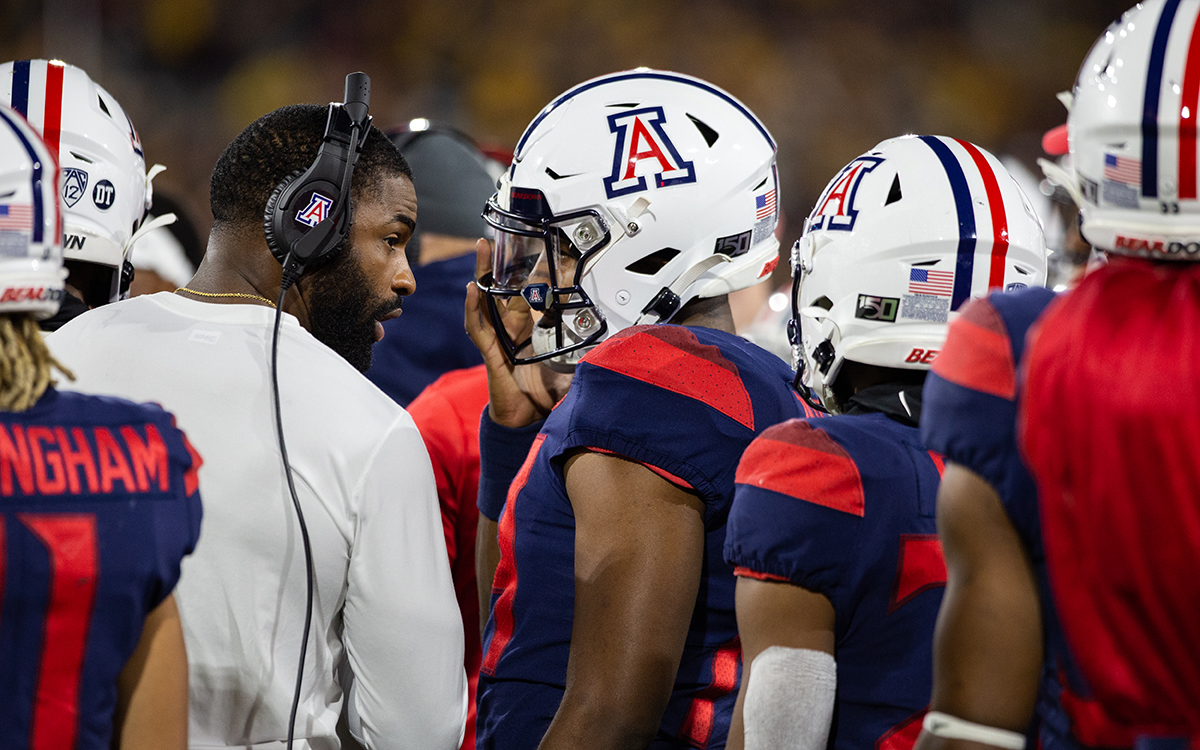
In his final weekly press conference of the season, the first question asked of Sumlin was why he thought Tate’s career “never took off” during Sumlin’s time at Arizona. Sumlin said there was “a lot of different reasons” and acknowledged the coaching change had a lot to do with it. When he was next asked if he’d have done anything differently, Sumlin took a bigger-picture look.
“We want the best for every player. We want the best for all of our players,” Sumlin said. “The quarterback position becomes one where there’s a lot more focus on that than there are other players on the team, because it’s the quarterback. That goes along with it.
“As a coach, you’re trying to make … if you don’t have a set system that you have to have, ‘You have to do this.’ But what we do have is we try to tailor, just like we’ve done defensively with getting all three linebackers on the field, or just like we’ve done with everything.”
Sumlin went on but concluded that, “Winning is the priority, and what that looks like can be a lot of different ways.” Perhaps nobody embodies that mentality more than Joiner, who redshirted in 2018 and transitioned from quarterback to wide receiver for 2019. In his first Territorial Cup game, Joiner had a breakout game, catching seven passes for 140 yards and two touchdowns, with the one game accounting for more than a quarter of his receiving yards on the season.
“For a guy who’s played receiver for basically for five months, he’s gotten better and better and better every week,” Sumlin said of Joiner. “He was still playing quarterback in June. He’s learned the position, he’s become a better route runner. He’s returning punts, too, he’s gotten there. He’s got a bright future.”
Joiner is happy that Sumlin is here, saying that the connection that a player has with his head coach is the most important one a college player can have.
“Me having a relationship with him, it’s bigger than football because that’s the thing you want to know from your coach, that they care about you as a person and care about how you’re doing off the field,” Joiner said. “My personal experience [with Sumlin] has been good. I’ve talked to him, vented to him, told him [about] my personal life. He’s been all ears, and he’s talked to me just like I’ve talked to him. Our relationship’s been really good.”
Sumlin will be around for 2020, and his offensive mixed in young players like Joiner and freshman quarterback Grant Gunnell, a 3-star recruit out of The Woodlands, Texas who started three games and played in eight, splitting reps with Tate for the majority of the season. The 6-foot-6, 225-pound quarterback finishing the season completing 101-of-155 passes (65.2-percent completion percentage) for 1,239 yards and nine passing touchdowns while only throwing one interception.
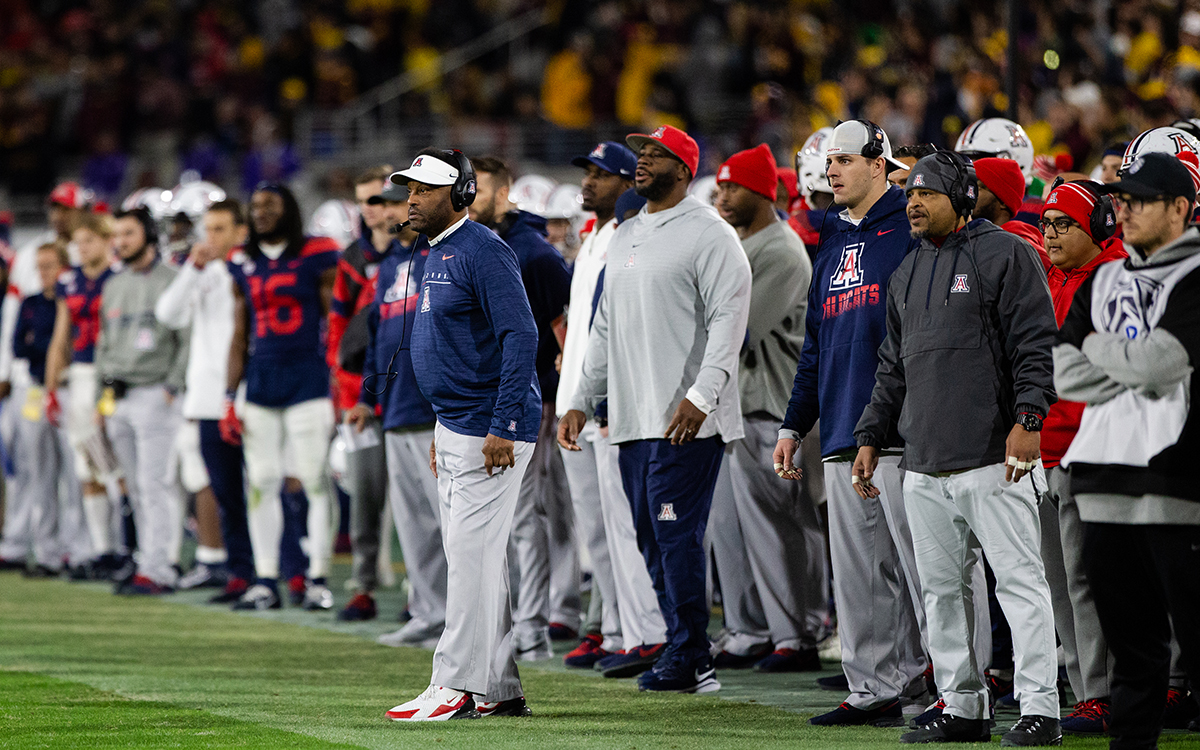
But all the positivity around his arrival and expectations for instant success has painted the coach and the program into a particularly tight corner after two underwhelming seasons. And while some, like Cooper, believe Sumlin should be given the chance to “get his guys in” and recruit the players he wants, there will need to be improvement in 2020 to get people back on board.
“If this was Arizona basketball, that’s a completely different subject,” Cooper said. “But this is Arizona football. People aren’t always expecting 10-win, 11-win seasons. Maybe they might expect 4 wins or 5 wins, like we’ve had the last two years, but if he doesn’t get to a bowl game next year, then his seat gets a lot hotter.”
